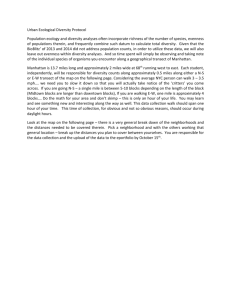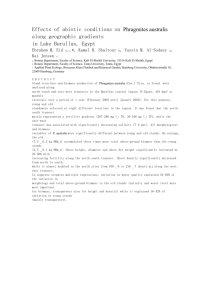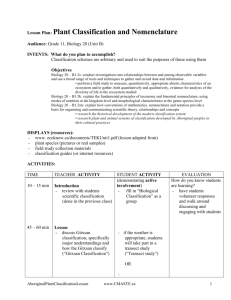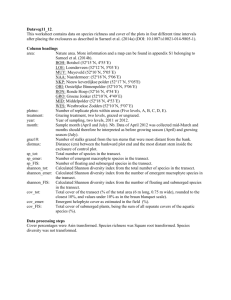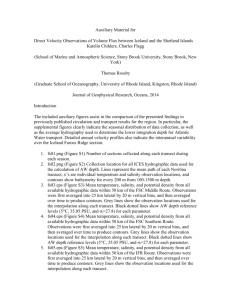baer assessment field form sept 2006 v2
advertisement
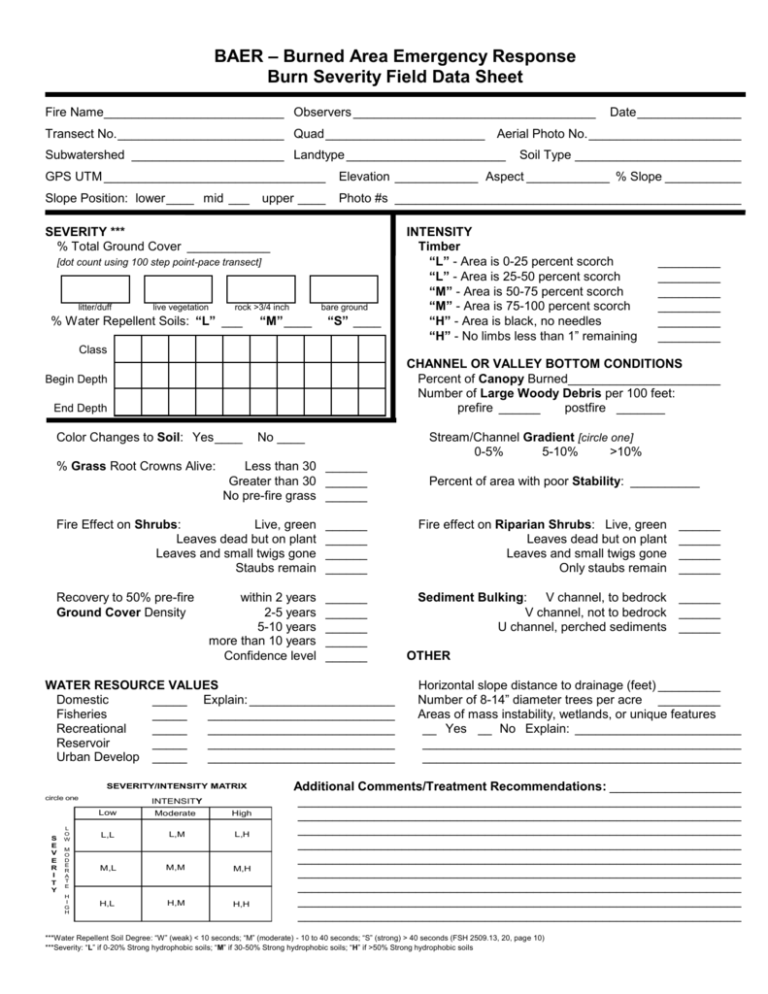
BAER – Burned Area Emergency Response Burn Severity Field Data Sheet Fire Name__________________________ Observers ___________________________________ Date _______________ Transect No. ________________________ Quad _______________________ Aerial Photo No. ______________________ Subwatershed ______________________ Landtype _______________________ Soil Type ________________________ GPS UTM ________________________________ Elevation ____________ Aspect ____________ % Slope ___________ Slope Position: lower ____ mid ___ Photo #s __________________________________________________ upper ____ SEVERITY *** % Total Ground Cover ____________ [dot count using 100 step point-pace transect] litter/duff live vegetation rock >3/4 inch % Water Repellent Soils: “L” ___ bare ground “M” ____ “S” ____ INTENSITY Timber “L” - Area is 0-25 percent scorch “L” - Area is 25-50 percent scorch “M” - Area is 50-75 percent scorch “M” - Area is 75-100 percent scorch “H” - Area is black, no needles “H” - No limbs less than 1” remaining _________ _________ _________ _________ _________ _________ Class CHANNEL OR VALLEY BOTTOM CONDITIONS Percent of Canopy Burned______________________ Number of Large Woody Debris per 100 feet: prefire ______ postfire _______ Begin Depth End Depth Color Changes to Soil: Yes ____ % Grass Root Crowns Alive: No ____ Stream/Channel Gradient [circle one] 0-5% 5-10% >10% Less than 30 ______ Greater than 30 ______ No pre-fire grass ______ Percent of area with poor Stability: __________ Fire Effect on Shrubs: Live, green Leaves dead but on plant Leaves and small twigs gone Staubs remain ______ ______ ______ ______ Fire effect on Riparian Shrubs: Live, green Leaves dead but on plant Leaves and small twigs gone Only staubs remain Recovery to 50% pre-fire Ground Cover Density ______ ______ ______ ______ ______ Sediment Bulking: V channel, to bedrock ______ V channel, not to bedrock ______ U channel, perched sediments ______ within 2 years 2-5 years 5-10 years more than 10 years Confidence level WATER RESOURCE VALUES Domestic _____ Explain: _____________________ Fisheries _____ ___________________________ Recreational _____ ___________________________ Reservoir _____ ___________________________ Urban Develop _____ ___________________________ SEVERITY/INTENSITY MATRIX circle one S E V E R I T Y INTENSITY L ow Moderate High L O W L ,L L,M L,H M O D E R A T E M ,L M ,M M,H H I G H H,L H,M H,H ______ ______ ______ ______ OTHER Horizontal slope distance to drainage (feet) _________ Number of 8-14” diameter trees per acre _________ Areas of mass instability, wetlands, or unique features __ Yes __ No Explain: ________________________ ______________________________________________ ______________________________________________ Additional Comments/Treatment Recommendations: ___________________ ________________________________________________________________ ________________________________________________________________ ________________________________________________________________ ________________________________________________________________ ________________________________________________________________ ________________________________________________________________ ________________________________________________________________ ________________________________________________________________ ________________________________________________________________ ***Water Repellent Soil Degree: “W” (weak) < 10 seconds; “M” (moderate) - 10 to 40 seconds; “S” (strong) > 40 seconds (FSH 2509.13, 20, page 10) ***Severity: “L” if 0-20% Strong hydrophobic soils; “M” if 30-50% Strong hydrophobic soils; “H” if >50% Strong hydrophobic soils BAER – Burned Area Emergency Response - Burn Severity Field Data Sheet Instructions digging into the soil to observe the root mass. Use your pre-fire All data, even the header information should represent the area surrounding observation to identify the percentage of remaining grass clumps. the transect. The role of the survey is to provide a representation of as INTENSITY - Fire Effect on Shrubs or Riparian Shrubs: Survey a pre-fire large a contiguous area as possible. The transect will serve a role in or unburned area before making these observations. This will help you modeling runoff and soil erosion, but can also be utilized to validate the determine a percentage of the pre-fire ground cover made up of shrubs. aerial severity map. By providing a mapped polygon that is represented by Evaluate the species of shrubs in the burned area and how fire affects these each transect it is possible to adjust the severity map to better fit on-thespecies. Use this to provide some recorded observations about the ground observations. potential for shrub regrowth. Identify the majority category or provide a Slope Position: Identify the transect location in terms of which 1/3 of the percentage in each category. slope. This will aid in assigning whether the slope is concave or convex Recovery to 50% pre-fire Ground Cover Density: Survey a pre-fire or in shape. Indicate with notes if possible. unburned area before making these observations. Discuss growing Photo #s: Identify photo numbers to represent each transect. One at the season and vegetation types with local specialists.(botanist). Observe beginning of each transect should suffice. the fire effects to the vegetation by evaluating the grass root systems, cutting into the shrub roots for moisture content, etc. Record what SEVERITY: Use a transect of 100 points (i.e. the point of your toe at each percentage of the pre-fire vegetation will recover and when. step or use 100’ tape and collect data every foot). Stratify transects to represent a contiguous section of estimated severity (aerial survey, BARC, other). Each transect should represent a single aerial estimate of severity. Pick a direction and walk in a straight line trying to keep the same slope position. The box is used as a dot count with measurements along the way and all the other information on the form is an observational assessment of what the transect represents as a whole. % Total Ground Cover: At every point, enter a dot count into a category of ground cover depending on what you’ve hit. It is usually all burned so make a call as to whether it is litter/duff, live vegetation (probably burned), rock, or bare ground. Calculate the number and percentage of each category after you’ve gotten to 100 and enter the additive percent of all categories except bare ground. This is your % Total Ground Cover. % Water Repellent Soils: The boxes for water repellency are used to measure every 10th pace or point of your transect starting with the 10th point in your transect. At every measurement, scrape the ground in at least 4 places at different depths. Start by scraping the ash off just enough to expose the surface of bare soil then proceed with depth intervals of ¼ to ½ inch. Use your water dropper to put a few drops on each scraped depth. Record the depth that repellency begins in the soil profile and where no degree of repellency exists (record the last (end) depth that repellency existed). Also, record the degree of water repellency at each depth using the categories at the bottom of the form. The class is based on the number of seconds that the drop of water remains on the soil surface and how deep the soil is repellent. Assess classes of water repellency by using the following rating system: Low - No strong repellency except at the immediate soil surface and no moderate repellency below 1/2 inch. Repellency is very spotty in occurrence. Medium - Some moderate repellency below 1/2 inch, but no strong repellency below 1 inch. High - Moderate repellency between 3 and 6 inches or strong repellency below 1 inch. The degree of repellency is uniform in extent. Color Changes to Soil: Depth and Color of Ashes is an observation of the transect as a whole so keep your head up for this measurement. Ashes are white or reddish color, indicating that much of the carbon was oxidized by the fire, especially if they are over 2 inches deep. This consistently indicates zones of intensive burn with long residence time. Sparse ashes that are dark in color usually indicate moderate to low intensity and short residence. % Grass Root Crowns Alive: Survey a pre-fire or unburned area before making these observations. This will help you determine a percentage of the pre-fire ground cover made up of grass. Then kick the grass clumps to determine how intact (live) the roots are, if it’s difficult to kick the clump out of the ground then the grass root crown is probably alive. Verify by Timber : Look up and around at the timber and overstory vegetation. Determine the percent of the tree’s height has been scorched by fire (give an average of the whole). Evaluate tree limbs as well as young trees (less than 1” diameter). INTENSITY/SEVERITY Matrix: Use the matrix to record the appropriate mix of intensity (identified by the fire effects to vegetation) and the severity (the combination of water repellency and ground cover consumption in the box). Circle the best box and provide explanation. WATER RESOURCE VALUES: Identify values near the transect that would help assess importance of that particular area. CHANNEL OR VALLEY BOTTOM CONDITIONS: Evaluate and record the percent of the canopy is consumed within the channel/valley bottoms. Estimate the large woody debris per 100 feet. Use prefire inventory, if available, for comparison. Estimate an average, even if the transect does not cross the channel but is represented within site distance of the transect. Stream/Channel Gradient: Measure the stream channel gradient and/or record the gradient. Estimate an average, even if the transect does not cross the channel but is represented within site distance of the transect. Percent of area with poor Stability: Record any visually obvious slope failures or bulking in the streams and on the slopes. Identified by cracks, debris deposits, or other indicators of slope instability. Sediment Bulking: Evaluate the channels, even if the transect does not cross the channel but is represented within site distance of the transect. Record whether the channel consists of bedrock and define it’s shape. Look closely at sections of the channel that have existing or burned riparian shrubs. Look for a wedge of sediment upstream from any vegetation. Sediment bulking is likely, if the channel shape looking directly up or downstream is U-shaped with perched sediments. OTHER - Horizontal slope distance to drainage (feet): Estimate and record the distance from the top of the slope (that drains to the channel) to the channel bottom. If the slope is broken by benches, concavity, or convexity distinguish distances above and below these breaks in the slope. Number of 8-14” diameter trees per acre: Record an estimate of the number of trees per acre at each represented area. If trees per acre is difficult, then break it down inot how many 20’ logs (6-12” diameter) could be cut and placed as log erosion barriers. Areas of mass instability, wetlands, or unique features: Describe unique features that would affect treatments or recommendations. Especially, identify features that could contribute to raising the risk or the consequences of the burned area and any recommended treatments (I.e. spawning redds, wetlands, debris jams already instream).

